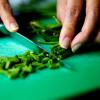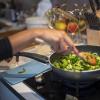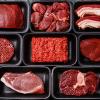The level of food safety in the Netherlands is extremely high, and has been for many years. It is nevertheless important to remain alert to potential threats. Food can contain micro-organisms which may cause illness. Micro-organisms may enter the food chain for instance during production or during home preparation.
Food can contain micro-organisms which may cause illness. Micro-organisms may enter the food chain for instance during production or during home preparation. Foods may also contain chemical contaminants, some of which can be harmful to health.
Micro-organisms
Micro-organisms include viruses, fungi, bacteria and parasites. Some of these pathogens cause illnesses directly, while others produce toxins that could be poisonous to humans. Micro-organisms can end up in food e.g. due to poor hygiene (for instance sneezing or unwashed hands) or cross-contamination (such as when raw meat and lettuce are chopped on the same cutting board). In some cases, they are simply present on the food, for instance, mould or other fungi on nuts. Exposure to micro-organisms in food can lead to food-borne infections or food poisoning.
Chemical contamination
Chemical substances (or residues) can end up in our food in various ways. They may occur naturally in food, or some chemicals may be licensed for use in food production processes. However, in some cases these substances are used or added illegally in the production process. In both cases, any quantity that might pose a health hazard should not end up in the food. Food in the Netherlands is generally safe. RIVM contributes to food safety by supporting governments with risk assessment, consultancy, methodology development and more.
What RIVM does
RIVM performs a number of tasks in the field of food safety. We develop models to determine food safety, and we maintain databases of relevant information. For example, we will determine the concentration at which a chemical substance will pose a risk to health, and how much of that substance a person can safely ingest. We also work on the further development of methods for risk assessment.
In the field of microbial food safety, we use a risk assessment tool called Quantitative Microbiological Risk Assessment (QMRA). This tool contains food chain models (‘farm-to-fork’) in which the prevalence and number of pathogens are followed.
International context
European legislation has been developed to ensure food safety. The Dutch government, together with other national authorities in Europe, is responsible for establishing, monitoring and enforcing laws and regulations to that end. RIVM advises the government in these matters, at the national and international levels. The Netherlands Food and Consumer Product Authority (NVWA) is responsible for supervision and enforcement in the Netherlands.
Research is increasingly being undertaken in the international context for organisations such as the EFSA and WHO/FAO . RIVM also researches food allergens, seeking to identify substances which cause an allergic reaction and the quantity of the substance which is likely to do so.
Based on research findings, RIVM advises various clients. They include the Ministry of Health, Welfare and Sport (VWS) and other Ministries, the Netherlands Food and Consumer Product Safety Authority (NVWA), the Board for the Authorisation of Plant Protection Products and Biocides (Ctgb), the Veterinary Medicinal Products Unit (BD), the European Food Safety Authority (EFSA), WHO and FAO.
International networks and activities
Projects
RIVM participated in the EuroMix project. Human biomonitoring studies show that people have a considerable number of human-made chemicals in their bodies. European regulations stipulate the need to consider the potential mixture effect in the nearby future. EuroMix has delivered an open web-based data and model platform for exposure, hazard and risk assessment. RIVM also has a partnership with EFSA. The focus of the work within this partnership lies on Monte Carlo Risk Assessment (MCRA) modelling. More international projects on food and nutrition, in which RIVM is involved, can be found in our international projects database.
WHO Collaborating Centres
RIVM hosts the World Health Organization (WHO) Collaborating Centres (CC) on Chemical Food Safety and of Risk Assessment Pathogens in Food and Water.
WHO CC on Chemical Food Safety was re-designated to RIVM in June 2017 for a period of four years. The WHO CC supports WHO with the Global Environment Monitoring System (GEMS) and the Food Contamination Monitoring and Assessment Programme. In the GEMS/Food programme, chemical contaminations in food and food consumption data is collected. This data is subsequently used to inform governments, organisations and Codex Committees about levels and trends of chemicals in food, their contribution to the total human exposure, and their relevance for public health and trade. Furthermore, RIVM supports WHO by developing new methodologies for risk assessment and by improving those that are currently used. Read more about this WHO CC on Chemical Food Safety.
WHO CC for Risk Assessment of Pathogens in Food and Water supports WHO with capacity building in the field of microbial food an water safety. Based on Quantitative Microbial Risk Assessment (QMRA), including e.g. hazard identification and risk characterisation, knowledge is generated and tools are developed to support WHO activities. Water and food are essential for human health. Numerous microbial hazards such as current an emerging pathogens threaten the safety of water and food. Microbial hazards include current risks such as Campylobacter, Toxoplasma, Rotavirus and emerging risks such as Ebola virus and antimicrobial resistance. Such risks should be identified. QMRA is one tool to assess the risks to human health. Our WHO CC has ample experience in QMRA to aid WHO Headquarters, WHO Europe and JEMRA. Read more about WHO CC for Risk Assessment of Pathogens in Food and Water.
Expert networks
RIVM participates in a variety of food and nutrition expert networks. In the area of chemical food safety, these include among others, networks of EFSA, EMA, FAO, WHO and OECD.
Sustainable Development Goals
RIVM's activities in the field of food safety contribute to SDG2 Zero hunger and SDG3 Good health and well-being.









